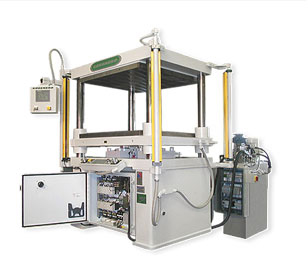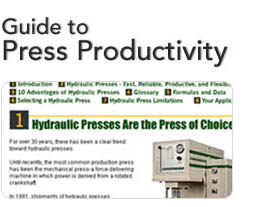| |
 |
|

Search Hydraulic Presses By:
Search Arbor Presses By:
|
|
 |
|

|
| Aug 01, 2018 | | Compression Molding for Aerospace Composites |
 Edited by Robert Schoenberger
Edited by Robert Schoenberger
Original Post
From design to manufacture, it can be challenging to achieve product consistency
with aerospace composite materials. Manual processes can lead to expensive,
time consuming rework machining for finished products, especially
with complex, layered materials such as carbon fiber reinforced plastics (CFRP).
However, using the correct composite production technology will reduce the
variation within a single component as well as from one component to the next.
“Good process control provided by new compression molding machines improve
the quality of the product and allow manufacturers to gain a deeper understanding
of the process,” says Mike Josefiak, mechanical engineer with Greenerd Press &
Machine Co.
Josefiak recently sat down with Aerospace Manufacturing and Design editors to
discuss how compression molding can improve parts consistency as aerospace companies
increasingly turn to lightweight, difficult-to-process composite materials.
AM&D: What is compression molding, and how does it
differ from other hydraulic forming technologies?
MJ: Compression molding uses temperature and
pressure, over time, to form, cure, and/or bond a
component. The material may be a fabric impregnated
with thermosetting resins, a partially cured
rubber, a molding compound – bulk molding
compound (BMC) or sheet molding compound
(SMC), or other materials that benefit
from a heating cycle under pressure.
AM&D: What are the best applications
for compression molding?
MJ: The desire for higher strength-to-weight
ratios in aerospace applications makes it a
natural fit for composite materials. Compression
molding creates structural components
for modern aircraft interiors, replacing aluminum
for weight and cost savings.
In more demanding applications, such
as the CFM Int’l. LEAP engines powering
the A320neo and 737 MAX, composite fan
blades are made in a compression molding
process. The high bypass ratios being used
to reduce fuel consumption have increased
blade size. These longer blades must resist
bird strikes with flexibility and strength,
always keeping component weight to a minimum.
This requires tight process control and
repeatability in the molding process.
Compression molding functions well,
producing components that have less
complex or fine features because many
materials do not flow freely. The best applications
will be thin – reducing the time
needed to cure material at the core of the
component, so cycle times do not become
unacceptably long.
AM&D: How does the process work?
MJ: Compression molding presses are very
flexible and can be tailored to meet the
needs of a specific component or families of
components. The three keys to a successful
compression molding process are managing
time, temperature, and pressure. Adjusting
these factors precisely to meet the chemical
and physical characteristics of a product
ensure consistent, successful results.
Sizes can range from a few inches to
many feet wide. Size, combined with
the desired pressure on the material, will
determine the machine’s capacity.
Pressures on the material range from
less than 100psi to more than 3,000psi.
Minimizing deflection of the machine platens, and controlling parallelism will
keep pressure consistent across the working
area.
Modern analysis and temperature
control methods can keep temperatures
within a few degrees. Systems compensate
for heat absorbed by the working
material and ambient condition changes
to maintain consistent ramp rates and
soak temperatures.
AM&D: Does the process work with thermoplastics
as well as thermosets?
MJ: Yes, thermoplastics and thermoset
materials can be used in this process,
although low viscosity fluids can be difficult
to contain within a metallic die, and
flashing is to be expected.
AM&D: Can compression molding be
used on metal parts?
MJ: The same style of presses used for
compression molding can also be used in
a warm- or hot-forming application for
metallic parts. While the energy and forces
required for these operations generally
increase, the same principles of controlled
heat and pressure can improve production
of metallic parts susceptible to tearing
or thinning. Heating many materials to
a small fraction of their melting points
makes it easier for materials to flow, helping
reduce the scrap rate of demanding
forming work.
AM&D: How do traditional hydraulic
presses and compression molding
presses differ?
MJ: Compression molding presses typically
use hydraulic power systems because
of the low power demand required for
holding a product under pressure, as well
as being a cost-effective way to achieve
tight force control.
Hydraulic press systems designed specifically
for compression molding will take
additional steps to smoothly transition
pressure on the product, maintain equal
force across the work area, and minimize
energy consumption.
AM&D: If starting a compression molding
operation, what features should be
considered in a press?
MJ: Control systems that manage temperature,
time, and pressure independently
throughout the cycle will give end users
the tools they need to succeed. Every
product is different, so the ability to test
and adjust conditions consistently leads to
reduced cycle times and lower scrap rates.
AM&D: Are there standard press
features, or are they all customized to
part-making requirements?
MJ: Temperature control of the working
surface, force control, and the ability to
hold pressure for long periods of time are
all basic functions in compression molding
presses. However, there are several options
to consider. The materials being formed
and the particularities of each die will
play the largest role in which options can
benefit a manufacturer.
Heater-zone controls can ramp up
temperature at a controlled rate across
the full working area. Additional cooling
systems provide similar controlled
temperature ramp-down. The level of
control and speed of temperature change
can be configured to match the needs of
the materials.
Position control can be added for products
with a required thickness, holding
positions as close as ±0.001". On large
products, this may be multiple cylinders
working in concert to maintain the position,
even as the material being formed
pushes outward on the dies.
Vacuum chambers around the working
area help remove additional gas within
the product, as well as limit oxidation or
contamination problems.
These are only a few of the possibilities.
Greenerd Press & Machine compression
molding presses are readily expandable,
supporting any number of operating
conditions to speed up production,
reduce scrap rates, and improve the end
product.
AM&D: What operator training is
needed, and how is it provided?
MJ: Operators can be trained on-site in
basic operation in less than an hour. Basic
systems typically use time, temperature,
and pressure setpoints for adjustment.
Advanced presses can become more
complex, using step programming with
ramp rates for temperature, position, and
force throughout set time periods. To
get the maximum potential from these
systems, it is critical to gain a deep understanding
of the material being formed and
how the conditions around that material
benefit the process. |
|
|
|


















